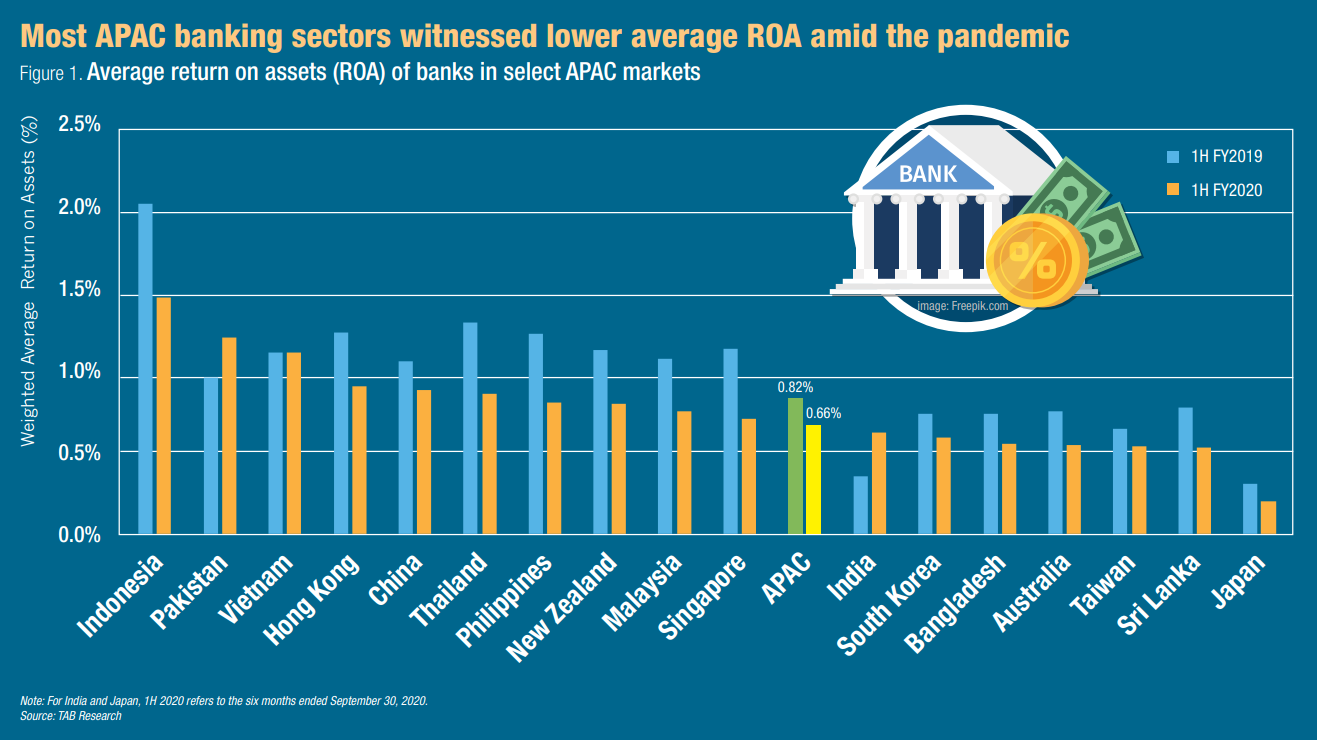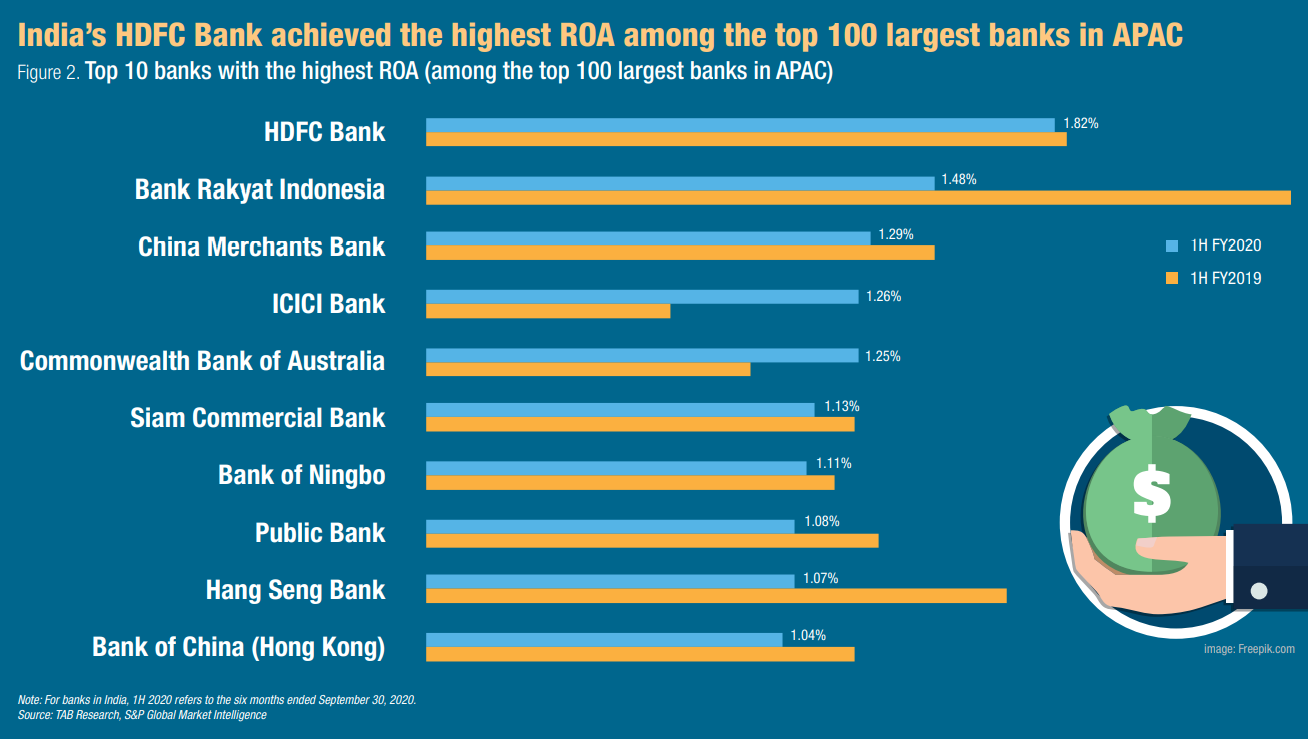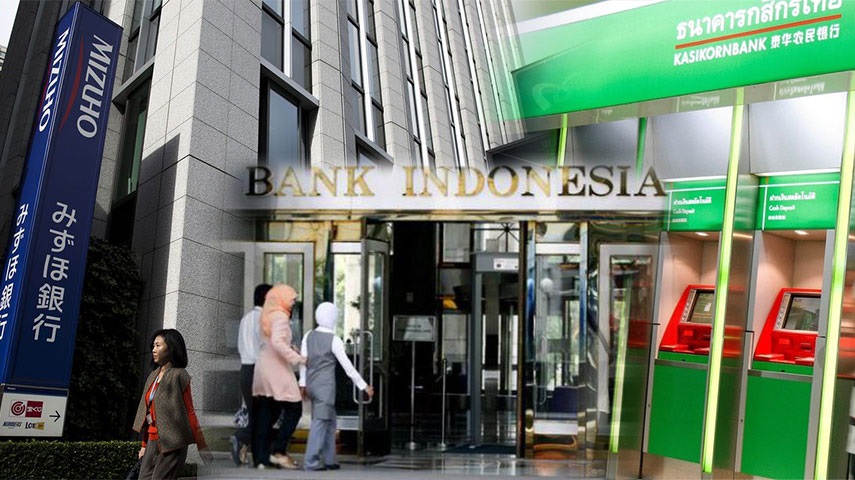Although the banking system remained resilient in 2020 amid the COVID-19 pandemic, profits have been hit hard. In Asia Pacific (APAC), the profitability of banks weakened as reflected by the drop in weighted average return on assets (ROA), an indicator of asset efficiency and profitability, from 0.82% in the first half of fiscal year 2019 (1H FY2019) to 0.66% in 1H FY2020 (Figure 1), according to The Asian Banker 500 (AB500), an evaluation of the top 500 largest banks in APAC.

The net interest margins of banks have been squeezed by the cuts in interest rates. Meanwhile, banks made larger loan loss provisions to prepare for the potential surge in non-performing loans especially after the financial aid measures introduced by regulators end. In addition, some economies witnessed slower credit growth.
Among the 18 markets in the region, Indonesia saw the largest drop in ROA. On average, the 23 Indonesian banks in the AB 500 ranking reported a 22.1% year-on-year (YoY) contraction in net profit in 1H 2020, compared to a 13.5% YoY increase over the same period a year earlier. Average ROA fell from 2% in 1H 2019 to 1.4% in 1H 2020. Despite this, Indonesian banks still enjoyed the highest ROA. In addition to the narrowed margins and rising loan loss provisions, weaker lending growth also contributed to the fall in ROA.
The average loan growth of these banks decelerated significantly from 14.3% YoY at the end of June 2019 to a mere 0.2% YoY at the end of June 2020. Loan demand was weak as business activity and consumer spending were stunted amid the pandemic. Meanwhile, Bank Indonesia (BI) said that commercial banks’ reluctance to cut lending rates in line with central bank easing resulted in the sluggish loan growth, and it therefore urged banks to further cut lending rates.
Average ROA of banks in countries like Thailand and Philippines also fell considerably. The 13 Thai banks on the list recorded lower average ROA at 0.85% in 1H 2020, compared to 1.29% in 1H 2019, while the average ROA of 10 banks from the Philippines fell from 1.22% to 0.8%. Bangkok Bank and Kasikornbank, the top 2 largest Thai banks by total assets, saw net profit plummet by 41% YoY and 49% YoY respectively in 1H 2020, driven by shrinking margins, lower non-interest income and higher loan loss provisions.
Despite a sharp decline in net profit, some banks achieved good pre-provision earnings. For instance, net profit of DBS in Singapore slid by 26% YoY in 1H 2020, but its pre-provision operating profit was up 12% YoY. In 1H 2020, the provisions DBS set aside against potential bad loans quintupled to $1.4 billion. BDO Unibank, the largest bank in the Philippines, recorded an 18.4% YoY increase in its pre-provision operating profit. The provisions it book in 1H 2020 was 7.5 times higher than that in 1H FY2019, and thus, it registered a 79% YoY plunge in its net profit.

The average ROA of Japanese banks fell from 0.31% for the six months ended September 30, 2019 to 0.2%, the lowest among these 18 markets. The banking sector has been facing profitability challenge for years due to ultra-low interest rates and an ageing and shrinking population. During COVID-19, Japanese banks offered more loans to smaller businesses hit by the pandemic, while increasing loan-loss provisions.
On the contrary, banks in India and Pakistan recorded higher ROA. The weighted average ROA of 29 Indian banks was higher at 0.62% for the six months ended September 30, 2020, compared with 0.35% over the same period a year earlier, partially fuelled by the easing credit costs. Fifteen out of these banks saw higher ROA, including State Bank of India (SBI) and ICICI Bank. The ROA of SBI improved from 0.36% to 0.5%, as its net interest income increased by 15% and loan loss provisions dropped by 34%. Both SBI and ICICI Bank reported lower gross non-performing assets ratio and higher provision coverage ratio. In Pakistan, the average ROA of the 13 banks on the list was up from 1% in 1H 2019 to 1.2% in 1H 2020, driven by higher net interest income and the significant increase in capital gain on government securities. On average, these banks saw net interest income grow by 30%, largely due to the delayed impact of cuts in interest rates.
HDFC Bank, the largest private bank in India, registered the highest ROA among the top 100 largest banks in APAC (Figure 2). The bank posted net profit growth of 18.7% YoY for the six months ended September 30, 2020, and its ROA fell slightly to 1.82% from 1.86% over the same period a year earlier. Its net interest income increased by 16.7% YoY, supported by the 15% YoY growth in net loans, and the provisions the bank set aside went up by 43% YoY. It is also the bank with the best asset quality in India. Bank Rakyat Indonesia placed second, with ROA falling remarkably from 2.51% to 1.48%.
Profitability is expected to be suppressed in the near term. Banks remain under pressure amid the low interest rate environment, as they struggle with the challenge of mounting distressed debts. Some banks will make less loan loss provisions in 2021 due to the substantial provisions they book in 2020. Apart from controlling costs, banks also need to accelerate digitalisaiton and grow alternative revenue streams to help bolster profitability.

































